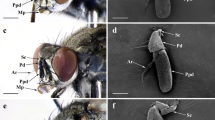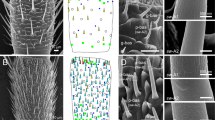Abstract
Extraocular photoreception has been reported in several orders of insects, and direct photoreception by the central nervous system (CNS) has been shown to be related to the circadian clock in many cases1. For example, CNS photoreceptors have been found in the brain and the last abdominal ganglion of the cockroach, Periplaneta americana, and in the brain of the silkworm, Hyalophora cecropia2. In other cases dermal light sensitivity has been deduced from behavioural responses. For instance, the larvae of Tenebrio molitor avoid light even after decapitation3. The antennae of Aphis fabae seem to be the site of light sensitivity responsible for the animal's photokinetic activity4. Dermal light sensitivity is demonstrable in all the tergites of the larvae of Acilius japonicus and Dytiscus marginalis, particularly well developed in the region of terminal abdominal spiracles5. We report here, however, the electrophysiological response and morphological characteristics of presumptive photoreceptive sites on the genitalia of the Chinese yellow swallowtail butterfly, Papilio xuthus L.
This is a preview of subscription content, access via your institution
Access options
Subscribe to this journal
Receive 51 print issues and online access
$199.00 per year
only $3.90 per issue
Buy this article
- Purchase on Springer Link
- Instant access to full article PDF
Prices may be subject to local taxes which are calculated during checkout
Similar content being viewed by others
References
Bennett, M. F. in Handbook of Sensory Physiology Vol. 7, 6A (ed. Autrum, H.) 641–664 (Springer, New York, 1979).
Saunders, D. S. Insect Clocks (Pergamon, Oxford, 1976).
Tucolesco, J. Bull. Biol. no. 4, 1–35 (1933).
Booth, C. O. Nature 197, 265–266 (1963).
Schöne, H. Z. vergl. Physiol. 33, 63–98 (1951).
Barber, V. C. et al. Z. Zellforsch. 76, 295–359 (1967).
Yamamoto, T. et al. J. Cell Biol. 25, 345–359 (1965).
Author information
Authors and Affiliations
Rights and permissions
About this article
Cite this article
Arikawa, K., Eguchi, E., Yoshida, A. et al. Multiple extraocular photoreceptive areas on genitalia of butterfly Papilio xuthus. Nature 288, 700–702 (1980). https://doi.org/10.1038/288700a0
Received:
Accepted:
Issue Date:
DOI: https://doi.org/10.1038/288700a0
This article is cited by
-
Biological impact of ultraviolet-B radiation on spider mites and its application in integrated pest management
Applied Entomology and Zoology (2021)
-
Ambient Illumination Influence on Photuris Firefly Larval Surface Movements is not Mediated by the Stemmata
Journal of Insect Behavior (2020)
-
Pheromones and body coloration affect mate recognition in the Japanese nine-spotted moth Amata fortunei (Lepidoptera: Arctiidae)
Journal of Ethology (2012)
-
Light on butterfly mating
Nature (1996)
-
Valva-opening response induced by the light stimulation of the genital photoreceptors of male butterflies
Naturwissenschaften (1993)
Comments
By submitting a comment you agree to abide by our Terms and Community Guidelines. If you find something abusive or that does not comply with our terms or guidelines please flag it as inappropriate.



